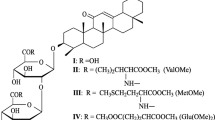Abstract
The membrane-active peptide,Pyrularia thionin, purified fromPyrularia pubera, was covalently conjugated to an anti-CD5 monoclonal antibody. The membrane-active properties of thionin were not affected by the conjugation. The immunotoxin killed CD5+ lymphocytes in vitro at a concentration of 0.1 nmol/107 cells after 2 h of incubation. The immunotoxin also inhibited the proliferation of T cells in vitro, stimulated either by mitogens or in the mixed lymphocyte reaction. It was shown by electron paramagnetic resonance of spin probes and differential scanning calorimetry that the ability of the immunotoxin to perturb the lipid phase of membranes is close to that of unconjugated thionin. The results obtained suggest thatPyrularia-thionin—anti-CD5 conjugate may be useful for graft-versus-host disease therapy and potentially in the treatment of CD5+ leukemia and lymphomas.
Similar content being viewed by others
References
Arasawa Y, Smith ICP, Schereier S (1981) Effects of amphotericin B on membranes: a spin probe study. Biochemistry 20:5702
Aripov TF, Gasanov SE, Salakhutdinov BA, Sadykov AS (1986) Studies on the interaction of cobra venom cytotoxin with oriented phospholipid multilayers. Dokl Akad Nauk SSSR 288:728
Berliner L (ed) (1979) Method of spin probes. Mir, Moscow
Chignola R., Anselmi C, Franceschi A, Pasti M, Candiani C, Tridente G, Colombatti M (1994) Sensitivity of human leukemia cells in exponential or stationary growth phase to anti-CdS immunotoxins — role of intracellular processing events. J Immunol 152:2333
Chiron M, Derocq JM, Kuhlein E, Roubinet F, Demur C, Grandejean H, Huguet F, Jaffrezou JP, Jansen F, Laurent G (1989) Sensitivity of fresh leukemic cells to T101 ricin-A-chain immunotoxin: a comparative study between Fab fragment and whole Ig conjugates. Leuk Res 13:491
Fitzgerald DJ, Morris RE, Saelinger CB (1980) Receptor-mediated internalization ofPseudomonas exotoxin by mouse fibroblast. Cell 21:867
Foon KA (1989) Laboratory and clinical application of monoclonal antibodies for leukemias and non-Hodgkin's lymphomas. Curr Probl Cancer 13:57
Friedman PN, Chace DF, Trail PA, Siegall CB (1993) Antitumor activity of the single-chain immunotoxin BR96 sFv-PE40 against established breast and lung tumor xenografts. J Immunol 150:3054
Gasanov SE, Aripov TF, Salakhutdinov BA (1989) Alteration of membrane dynamic structure by Central Asian cobra venom cytotoxins. Dokl Akad Nauk Uzb SSR 2:51
Gasanov SE, Aripov TF, Salakhutdinov BA (1990) Intermembrane exchange with lipids induced by cobra venom cytotoxin. Biofizika 35:958
Gasanov SE, Kamaev FG, Salakhutdinov BA, Aripov TF (1990) Investigation of toxic peptides' fusogenic properties on model membrane systems. Biol Nauki 2:42
Gasanov SE, Salakhutdinov BA, Aripov TF (1990) Formation of nonbilayer structures in phospholipid membranes induced by cationic polypeptides. Biol Membr 7:1045
Gasanov SE, Vernon LP, Aripov TF (1993) Modification of phospholipid membrane structure by the plant toxic peptidePyrularia thionin. Arch Biochem Biophys 301:367
Grossbard ML, Nadler LM (1992) Immunotoxin therapy of malignancy. Important Adv Oncol 7:111
Hudson L, Hay FC (1980) Practical immunology. Blackwell, London
Jaffrezou J-P, Laurent G (1993) The intriguing link between modulation of both multidrug resistance and ligand-toxin conjugate toxicity. FEBS 323:191
Jaffrezou J-P, Sikic BI, Laurent G (1994) Cyclosporin A and cyclosporin SDZ PSC 833 enhance anti-CD5 ricin A-chain immunotoxins in human leukemic T cells. Blood 83:482
Kreitman RJ, Bailon P, Chaudhary VK, Fitzgerald DJ, Pastan I (1994) Recombinant immunotoxins containing anti-Tac(Fv) and derivatives ofPseudomonas exotoxin produce complete regression in mice of an interleukin-2 receptor-expressing human carcinoma. Blood 83:426
Pai LH, Pastan I (1993) Immunotoxin therapy for cancer. JAMA 269:78
Porro G, Bolognesi A, Caretto P, Gromo G, Lento P, Mista G, Sciumbata T, Stirpe F, Modena D (1993) In vitro and in vivo properties of an anti-CD5-momordin immunotoxin on normal and neoplastic T lymphocytes. Cancer Immunol Immunother 36:346
Press OW, Vitetta EA, Farr AG, Hansen JA, Nartini PJ (1986) Evaluation of ricin A-chain immunotoxins directed against human T cells. Cell Immunol 102:10
Ravel S, Casellas P (1990) Internalization of cytotoxic molecules of T101 F(ab′)2 ricin A chain immunotoxin into human T leukemia cells. Eur J Biochem 192:469
Ravel S, Colombati M, Casellas P (1992) Internalization and intracellular fate of anti-CD5 monoclonal antibody and anti-CD5 ricin A-chain immunotoxin in human leukemic T cells. Blood 79:1511
Royston I, Majda JA, Baird SM, Meserve BL, Griffin JC (1980) Human T-cell antigens defined by monoclonal antibodies: the 65,000 dalton antigen on T-cells (t65) is also found on chronic lymphocyte cells bearing surface immunoglobulin. J Immunol 126:725
Siena S, Villa S, Bregni M, Bonadonna G, Gianni AM (1987) Amantadine potentiates T-lymphocyte killing by an anti-pan-T cell (CD5) ricin A-chain immunotoxin. Blood 69:345
Siena S, Bregni M, Formosa A, Martineau D, Lappi DA, Bonadonna G, Gianni AM (1988) Evaluation of antihuman T-lymphocytes saporin immunotoxin potentially useful in human transplantation. Transplantation 46:747
Stanker LH, Vanderlaan M, Juarez-Salinas H (1985) One step purification of mouse monoclonal antibody from ascites fluid by hydroxylapatite chromatography. J Immunol Methods 76:157
Tepler I, Schwartz G, Parker K, Charette J, Kadin ME, Woodworth TG, Schnipper LE (1994) Phase I trial of an interleukin-2 fusion toxin (Dab488II-2) in hematologic malignancies — complete response in a patient with Hodgkin's disease refractory to chemotherapy. Cancer 73:1276
Theuer CP, Pastan I (1993) Immunotoxins and recombinant toxins in the treatment of solid carcinomas. Am J Surg 166:284
Vernon LP (1992)Pyrularia thionin: physical properties, biological responses and comparison to other thionins and cardiotoxin. J Toxicol 11:169
Vernon LP, Bell JD (1992) Membrane structure, toxins and phospholipase A2 activity. Pharmacol Ther 54:269
Vernon LP, Evett GE, Zeikus RD, Gray WR (1985) A toxic thionin fromPyrularia pubera: purification, properties, and amino acid sequence. Arch Biochem Biophys 238:18
Author information
Authors and Affiliations
Rights and permissions
About this article
Cite this article
Gasanov, S.E., Rael, E.D., Gasanov, N.E. et al. In vitro evaluation ofPyrularia thionin—anti-CD5 immunotoxin. Cancer Immunol Immunother 41, 122–128 (1995). https://doi.org/10.1007/BF01527408
Received:
Accepted:
Issue Date:
DOI: https://doi.org/10.1007/BF01527408




